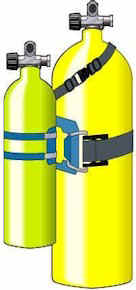Classification of Marine Organisms (2/3)
Definitions
Kingdom
This is the largest unit of classification. Initially it was thought that there were only two kingdoms, plants and animals. Eventually microscope and other tools helped clarify the existence of other types of organisms. Now, there are a total of 5 Kingdoms:
- Monera - 10,000 species - blue-green algae or cyanobacteria.
- Protista - 100,000 species - single-celled organisms and algae
- Animalia - over 1 million named species - fish, humans
- Plantae - 350,000 species - trees, grass
- Fungi - 100,000 species - mushrooms, lichen
Phylum / Division
Phylum is the next most specific unit of classification. This further divides each Kingdom into 20 or so divisions based on very distinct and defining characteristics. For example, within the Animal Kingdom, a major phylum is Chordata - animals with notochords. This includes humans, fish, mammals, etc.
For historical reasons, the Plant Kingdom is separated at this level into Divisions, while all other Kingdoms are separated into Phylums. The two levels are equivalent.
Class
This further classifies the organism, separating them into categories that make them very similar in terms of certain basic features. For example, within Phylum Chordata, the class Mammalia includes all animals that breastfeed, which includes humans, cows, dolphins, etc. Another class would be Reptilia, which includes cold-blooded and scaled animals.
Order
Organisms of the same Order are more similar that that of the same Class. A lot of obvious evolutionary connections can be drawn from looking at the Order; only a few features separate the organisms as a breaking in the evolutionary chain. One example is that within the class Mammalia, carnivores are separated into the order Carnivora while Insect-eaters are separated into the order Insectivora.
Family
Even more specific, the animals within this level share a very close similarity between each other. Most will probably have the same behavior patterns, feeding habits, and general functions. An example is within the Order Carnivora the Cat Family ( Felidaes ) which all have whiskers, sharp claws, and include animals such as Lions and House Cats.
Genus / Species
Genus is the part that makes up the first word of the binomial nomenclature of an organism. All the organisms within their genus may look very similar to each other. And although it is at most times not healthy, organisms of the same genus may breed with each other.
The most specific unit of classification is the species. The species makes up all the organisms and their apparent ancestors and descendants. Members of the species are much similar to their parents and can freely breed with other members of the same species without much complication.
History of Classification

Originally, when Linnaus founded taxonomy, organisms were divided based on solely visible physical characteristics. Now they're separated based on any unique and defining features, mainly external physical features, and secondarily based on other features such as feeding habits.
Each organism's scientific name is based on a binomial nomenclature in which an organism has two words to its name. The first word is the genus and the second word is the species. For example, humans are scientifically called Homo sapiens - genus Homo, species sapiens. The words that make up the names for the individual groups of taxonomy are based on the Greek or Latin language. This makes for a universal language throughout the world. Otherwise, an English scientist mentioning a "cat" to a Chinese person would be misunderstood because of language differences.
There are international commissions that help filter and record an updated listing of the classifications. Some names are based on the equivalent characteristics of the organism in Latin, or they could have no meaning at all and are just named after their founder.

